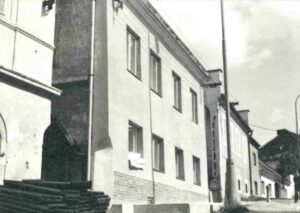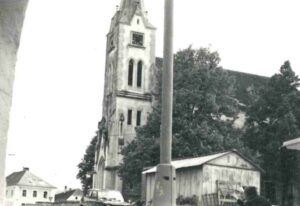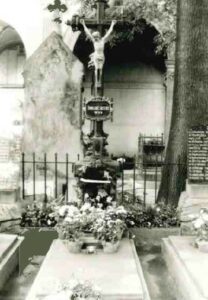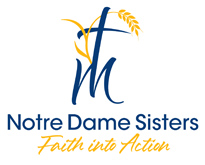Rev. Gabriel Schneider

Rev. Gabriel Schneider’s birthplace. The pillows in the window mark where he was born
The immediate founder of the Czech branch of the Poor School Sisters de Notre Dame, Gabriel Schneider, was born in Krems, Bohemia on March 21, 1812. His pious parents, Matthew and Rose nee Zimmerman, were of the laboring class. Gabriel attended the village school from the sixth to his twelfth year, after which he was “exchanged” for one year into a German miller’s family to learn the German language. His elementary education complete, it was evident that Gabriel was too weak physically to engage in any trade. Gabriel begged to continue his studies. He continued higher studies at Bohemian Budweis, and later pursued philosophical studies. On July 25, 1837 he was ordained a priest.
His first assignment was as assistant to a blind pastor at Klenci, where he labored in the pulpit and the confessional, and spread devotion to his adopted patron, St. John Nepomucene. A year later he was appointed to Mrakov where he organized the women, boys and girls into groups for guidance, giving them many salutary maxims for their spiritual growth.

Church where Rev Gabriel Schneider was baptised
Father Schneider periodically went to a distant Franciscan monastery for spiritual direction, but because of the distance, sought the direction of the zealous pastor of Hirschau. In 1842, Father Gabriel was transferred to Hirschau which was originally just a chapel. Through the benevolence of Andrew Schmidpetr, the chapel was enlarged into a parish church. Here, Father organized a Girls’ Sodality because he recognized the need of a well-trained womanhood. His observance of the conduct of the girls trained by the Sisters of Notre Dame in Munich as compared to the influence of secular training received in Prague convinced him of the need of bringing into Hirschau an institution for the education of girls.
During a serious illness, Father Schneider had a dream in which the Blessed Mother led girls to him. Then the pastor’s sister asked his advice concerning her wealth. Already Margaret Grall and Barbara Seidl knew of his project and promised financial aid and volunteered to work for him. With these promises and financial aid, Father started to build a parochial convent school in Hirschau. Both women were sent to Gratz, Stiermark to be trained by the School Sisters of St. Francis. Father Schneider was informed that the two girls would be candidates for a year and in the novitiate another year. When they returned to Hirschau in two years, an experienced professed Sister would be their superior for three years.

Meanwhile Father continued building, despite difficulties, misunderstandings, and lack of finances. In December 1847 he sent two more candidates, Marie Grall and Teresa Baumann to the Franciscan convent for training. On May 15, 1847, Margaret Grall and Barbara Seidl received the religious habit and the names Johanna Nepomucene and Magdalene, respectively. In 1848, Sr. M. Magdalene Seidl and four Hirschau candidates settled in the unfinished building and in October the school officially opened. The building was completed in 1849. Father petitioned the Notre Dame Sisters of Munich to take over the school. Mother Teresa Gerhardinger not only promised to give him the required number of Sisters but also requested that the candidates be sent to Munich for further training. This delighted Father, but then, Mother Teresa informed him that she could not send the Sisters to Hirschau.
It was Father Schneider’s intention that the Bavarian Notre Dame Sisters would have the parish school in Hirschau as their mission. The constant struggle to obtain Sisters for his parish, conflict between Rome and the Bavarian branch of Sisters, and disputes over the reception of novices for profession and candidates for reception led Father to realize that there was no solution. The Bishop of Budweis, the Archbishop of Munich, and the Titular Bishop of Olomouc, counseled Father Schneider to found an order of Notre Dame Sisters in Hirschau. On August 30, 1852, Father Schneider returned from Munich with the nucleus of the future Czech congregation of the Poor School Sisters de Notre Dame. The first profession of two novices and the reception of six candidates became a reality on August 15, 1853. Sr. M. Remigia was appointed superior and Sr. M. Armella novice mistress. In one year, Hirschau became too small. In 1854 Father bought a deserted monastery in Horazdovice. On October 9, 1854 the Sisters moved in. Twenty days later, they had the first reception and profession in the new General Motherhouse. Six novices were professed and six candidates invested. The first General Superior, Sr. M. Teresa Franz, was elected.
Father Schneider was very conscious of the importance of access to educational institutions of higher learning, so in 1857 he established a house in Prague which he converted into a convent and normal school. This became St. Ann’s College.
In 1860, when the Archbishop of Kalocsa, Hungary begged for School Sisters for his diocese, he sent five Hungarian girls to Horazdovice as candidates. When these girls were invested, Mother Teresa and two other Sisters accompanied them to Kalocsa. Mother Teresa noted the huge, completely equipped building that was available to the Sisters. She tried to persuade Father Schneider to make the General Motherhouse in Hungary. When he refused, she remained in Hungary when the other Sisters returned to Horazdovice.

Final burial place for Rev. Gabriel Schneider
Father Schneider acted as the Superior General, until 1864 when he arranged for a General Chapter. One of the original six postulants who received the habit at Hirschau in 1853, Sr. M. Jane Nepomucene, was elected Superior General.
With the young congregation completely organized, Father Schneider moved to St. Ann’s in Prague and left the worries of the congregation in the capable hands of Mother M. Jane.
All of Father Schneider’s life and activities were accompanied by chronic physical ailments. He became quite ill in December 1866. He lingered, suffering more and more until he quietly died on February 15, 1867. Thus passed to his eternal reward a priest, a Father, a Mother, a founder, but most of all a SAINT, whose sanctity lies hidden in the spirit he bequeathed to the Congregation dedicated to our Blessed Lady.
Source: “Rev. Gabriel Schneider” by Sr. Barbara Markey, ND
